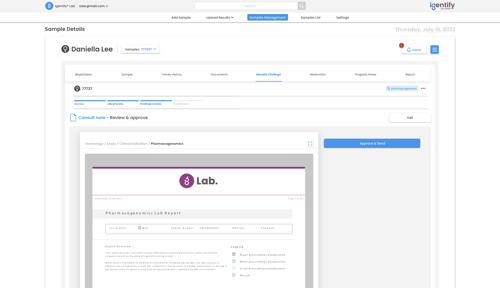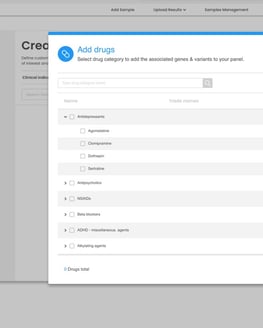Pharmacogenomics (PGx) gives insight into how a person’s genes affect how they respond to therapeutic medications. By understanding an individual’s genetic foundation, clinicians will be able to better predict how patients might respond to a drug before it is prescribed. Adverse drug reactions – which can be fatal – cost the US over $30B and have been estimated to be the 4th leading cause of death in the US.[1] Using PGx, providers and patients could avoid harmful and unwanted adverse drug reactions, side effects, and ineffective medications while reducing costs. However, to date, PGx usage has been limited. We asked Doron Behar, MD, PhD, Co-Founder and Chief Executive Officer, and Elliott Greenspan, Co-Founder and Chief Innovation Officer of Igentify, for their take on why. With combined experience of over 40 years working in genetic testing laboratories, they share their expertise-informed perspective here.
What’s your view on pharmacogenomics?
 Doron Behar, MD, PhD: I’m still surprised that PGx testing is not part of every person’s care. A PGx report can be obtained quickly, easily, and inexpensively as part of routine testing. The details of how an individual would react to specific medications is so useful, and this information could serve the individual many times over their lifetime. PGx is one component of personalized medicine – treating individuals based on their genetic characteristics, as opposed to following more general mass guidance. Since PGx is still relatively “new”, there is lots about it that the public and labs don’t know about, yet.
Doron Behar, MD, PhD: I’m still surprised that PGx testing is not part of every person’s care. A PGx report can be obtained quickly, easily, and inexpensively as part of routine testing. The details of how an individual would react to specific medications is so useful, and this information could serve the individual many times over their lifetime. PGx is one component of personalized medicine – treating individuals based on their genetic characteristics, as opposed to following more general mass guidance. Since PGx is still relatively “new”, there is lots about it that the public and labs don’t know about, yet.
 Elliott Greenspan: My personal opinion is that PGx testing should be done for everyone, like how newborn screening is done at birth – everyone should get it. Currently, in the US, reimbursement for PGx is dependent on medical necessity[2]. This is good, because every person who gets PGx testing done now probably will see a clinical benefit – there are typically at least a few things discovered that are valuable to the patient. The problem is, we don’t know how an individual might respond to a medication until they try it, and their body responds. The outcome could be that the medication helps, or it could be that it has no effect, or it could have negative side effects of varying degrees from minor to severe (even fatal.) Why would we take the chance of someone having a negative (or no) outcome after taking a medication, instead of testing early on to know what will work best based on their genes?
Elliott Greenspan: My personal opinion is that PGx testing should be done for everyone, like how newborn screening is done at birth – everyone should get it. Currently, in the US, reimbursement for PGx is dependent on medical necessity[2]. This is good, because every person who gets PGx testing done now probably will see a clinical benefit – there are typically at least a few things discovered that are valuable to the patient. The problem is, we don’t know how an individual might respond to a medication until they try it, and their body responds. The outcome could be that the medication helps, or it could be that it has no effect, or it could have negative side effects of varying degrees from minor to severe (even fatal.) Why would we take the chance of someone having a negative (or no) outcome after taking a medication, instead of testing early on to know what will work best based on their genes?
Why might a laboratory not offer PGx testing already?
DB: I suspect if a lab (whether it is a commercial/reference or an in-house/provider lab) doesn’t offer PGx, it is because they are one of the following:
Unaware of the potential ofPGxConcerned about the cost of adding this additional testLacking the proper equipment and technology to run PGx testsWorried about reimbursement and/or cost for PGx testing
EG: Not that long ago, in 2012, the American Medical Association (AMA) established current procedural terminology (CPT) codes for PGx tests.[3] Unfortunately, before the COVID-19 pandemic, several companies were fraudulently “code-stacking” or bundling claims, billing for services not provided, or blanket ordering.[4] Updated CPT codes were established in 2021 and updated in 2022, and new requirements and policies for PGx testing were issued.[2] It’s possible that some labs may not be fully aware of these new codes or may be extra-cautious with PGx, given its history. Another potential reason why PGx may not be offered is because of the very limited supply of clinical pharmacists or pharmacogenomic specialists (there are even fewer of these specialists than there are of Genetic Counselors) who can help translate genetic test results into medication choices. There are issues of coverage by Medicare. For example, CMS says that “when genetic tests are used for predictive purposes, CMS considers them to be screening tests and therefore they are not covered by Medicare.”[4] Lastly, at the moment, reimbursement for PGx testing relies on medical necessity and a prescription, which reduces the number of people who are eligible, so labs might assume that PGx test volumes could be limited.

Given this, why should a laboratory consider adding PGx testing?DB: As a physician, I see PGx as evidence-based medicine. It can help people get better faster or take more effective medications and has a significant effect on medical outcomes. Most labs have the goal of providing test results and information to help patients and their providers make informed healthcare decisions. PGx is absolutely a way to do that.
EG: I recently read that up to 50% of prescribed psychotropic medications do not have their intended effects on the first try in a new patient. Not only is this dangerous, but it is also expensive, time-consuming, and wasteful. PGx testing could really help here. Providers are already prescribing medications and testing patients’ blood to make sure the medications are metabolizing correctly. In addition, with the new established CPT codes, PGx is now reimbursed with generally strong reimbursement rates. Adding PGx to a lab’s menu of services would not only help more patients, but it could also improve the lab’s revenue to fund future projects or equipment.
How can Igentify’s platform help with PGx?
DB: Igentify has developed a medical-grade, end-to-end solution that connects fragmented steps in a lab’s workflow. If a lab wants to add PGx testing to their menu of services, we could help them quickly because our software is compatible with any microarray technology and we have built integrations to key databases and LIMS. We specifically built our platform to:
- Reduce manual work required
- Increase automation (with control)
- Integrate with important databases or systems
- Streamline steps and systems
Our platform is unique for a few reasons. We support expanded carrier screening (ECS) and chromosomal microarray analysis (CMA), and for those indications, our platform has patient-facing modules including registration, education, and consent. For ECS, CMA, and PGx, our platform also includes genotyping, clinical interpretation, workflows, integrations, and reporting. Igentify’s platform provides deep visibility into what data is being processed and how it’s being processed, giving insights earlier in the process as to what the genotypes are. We built tools (like our Igentify advanced clustering) that can get results from probes that most other solutions cannot get – in fact, we can call at a rate of about 93% of star alleles, whereas other solutions get to maybe 85%. This helps us get much more information out of raw data than others. Our digitized solution can help labs run (more) PGx tests in a responsible way, which could help them increase volumes and decrease turnaround time. And, our reports include drug-gene-drug interactions, adding additional insight and clarity.
 Screenshot of the Igentify PGx report screen
Screenshot of the Igentify PGx report screen
EG: In addition, our platform allows lab directors quite a bit of choice. Our paneling technique is unique. For example, a lab could request specific panels to be done (e.g., an oncology therapeutic panel, a psychiatric therapeutic panel, etc.) – we offer 6 pre-selected panels, or the lab could build its own. For liability protections, they can order only the panel needed so that a medical oncologist isn’t receiving or reviewing a cardiology panel, for example. Also, we’ve carefully designed our user experience thanks to lots of feedback from actual lab-based professionals. Our platform can really speed up their processes, as it was built with them in front of mind.
 Screenshot of the Igentify PGx panel builder
Screenshot of the Igentify PGx panel builder
What resources or publications would you recommend for anyone looking to learn more about PGx in lab settings?
DB and EG: We recommend:
- The Clinical Pharmacogenetics implementation consortium (CPIC), a group that creates, curates, and posts freely available, peer-reviewed, evidence-based, updatable, and detailed gene/drug clinical practice guidelines
- PharmGKB, which collects and disseminates knowledge about clinically actionable gene-drug associations and genotype-phenotype relationships
To learn more about Igentify’s PGx capabilities, please reach out to our team and we’d be happy to tell you more.
[1] Preventable Adverse Drug Reactions: A Focus on Drug Interactions. US Food and Drug Administration. Published March 2018. Accessed 4 October 2022.
[2] Billing and Coding: Pharmacogenomics Testing. Centers for Medicare and Medicaid Services. Published December 2021, updated February 2022. Accessed 6 October 2022.
[3] Hefti, E., and Blanco, J. Documenting Pharmacogenomic Testing with CPT Codes. The American Health Information Management Association. Accessed 5 October 2022.
[4] Trends in Genetic Tests Provided Under Medicare Part B. US Department of Health and Human Services, Office of Inspector General. Published December 2021. Accessed 6 October 2022.
If you’re interested in subscribing to this blog to get email alerts when we publish a new post, please fill out the form below.
